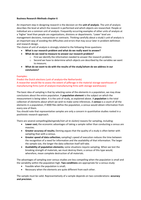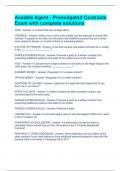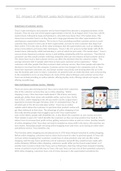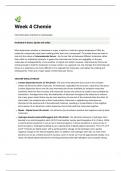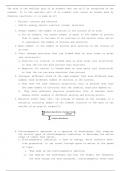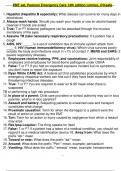Business Research Methods chapter 6
An important step in designing research is the decision on the unit of analysis. The unit of analysis
describes the level at which the research is performed and which objects are researched. People or
individual are a common unit of analysis. Frequently occurring examples of other units of analysis at
a ‘higher’ level than people are organizations, divisions or departments. ‘Lower’ level are
management decisions, transactions or contracts. Thinking carefully about a study’s unit of analysis is
an important way of avoiding the difficulties and errors that may occur later in problem definition
and research design.
The choice of unit of analysis is strongly related to the following three questions:
What is our research problem and what do we really want to answer?
What do we need to measure to answer our research problem?
o First we identify the information needed to answer the research problem;
o Second we have to determine which objects are described by the variables we want
to measure;
What do we want to do with the results of the study/whom do we address in our
conclusions?
Examples:
Predict the Dutch elections (unit of analysis=the Netherlands)
A researcher would like to assess the extent of pilferage in the material storage warehouses of
manufacturing firms (unit of analysis=manufacturing firms with storage warehouses)
The basic idea of sampling is that by selecting some of the elements in a population, we may draw
conclusions about the entire population. A population element is the subject on which the
measurement is being taken. It is the unit of study, as explained above. A population is the total
collection of elements about which we wish to make some inferences. A census is a count of all the
elements in a population; if 4000 files define the population, a census would obtain information from
every one of them.
You should note that representative samples are only a concern in quantitative studies rooted in a
positivistic research approach.
There are several compelling(dwingende/niet uit te sluiten) reasons for sampling, including:
Lower cost; the economic advantages of taking a sample rather than conducting a census are
massive;
Greater accuracy of results; Deming argues that the quality of a study is often better with
sampling than with a census.
Greater speed of data collection; sampling’s speed of execution reduces the time between
the recognition of a need for information and the availability of that information. The larger
the sample size, the longer the data collection itself will take.
Availability of population elements; some situations require sampling. When we test the
breaking strength of materials, we must destroy them; a census of this type would,
wherefore, mean complete destruction of all materials.
The advantages of sampling over census studies are less compelling when the population is small and
the variability within the population high. Two conditions are appropriate for a census study:
Feasible when the population is small;
Necessary when the elements are quite different from each other.
The sample must be valid. Representatively of a sample depends on two considerations: accuracy
and precision.
An important step in designing research is the decision on the unit of analysis. The unit of analysis
describes the level at which the research is performed and which objects are researched. People or
individual are a common unit of analysis. Frequently occurring examples of other units of analysis at
a ‘higher’ level than people are organizations, divisions or departments. ‘Lower’ level are
management decisions, transactions or contracts. Thinking carefully about a study’s unit of analysis is
an important way of avoiding the difficulties and errors that may occur later in problem definition
and research design.
The choice of unit of analysis is strongly related to the following three questions:
What is our research problem and what do we really want to answer?
What do we need to measure to answer our research problem?
o First we identify the information needed to answer the research problem;
o Second we have to determine which objects are described by the variables we want
to measure;
What do we want to do with the results of the study/whom do we address in our
conclusions?
Examples:
Predict the Dutch elections (unit of analysis=the Netherlands)
A researcher would like to assess the extent of pilferage in the material storage warehouses of
manufacturing firms (unit of analysis=manufacturing firms with storage warehouses)
The basic idea of sampling is that by selecting some of the elements in a population, we may draw
conclusions about the entire population. A population element is the subject on which the
measurement is being taken. It is the unit of study, as explained above. A population is the total
collection of elements about which we wish to make some inferences. A census is a count of all the
elements in a population; if 4000 files define the population, a census would obtain information from
every one of them.
You should note that representative samples are only a concern in quantitative studies rooted in a
positivistic research approach.
There are several compelling(dwingende/niet uit te sluiten) reasons for sampling, including:
Lower cost; the economic advantages of taking a sample rather than conducting a census are
massive;
Greater accuracy of results; Deming argues that the quality of a study is often better with
sampling than with a census.
Greater speed of data collection; sampling’s speed of execution reduces the time between
the recognition of a need for information and the availability of that information. The larger
the sample size, the longer the data collection itself will take.
Availability of population elements; some situations require sampling. When we test the
breaking strength of materials, we must destroy them; a census of this type would,
wherefore, mean complete destruction of all materials.
The advantages of sampling over census studies are less compelling when the population is small and
the variability within the population high. Two conditions are appropriate for a census study:
Feasible when the population is small;
Necessary when the elements are quite different from each other.
The sample must be valid. Representatively of a sample depends on two considerations: accuracy
and precision.


